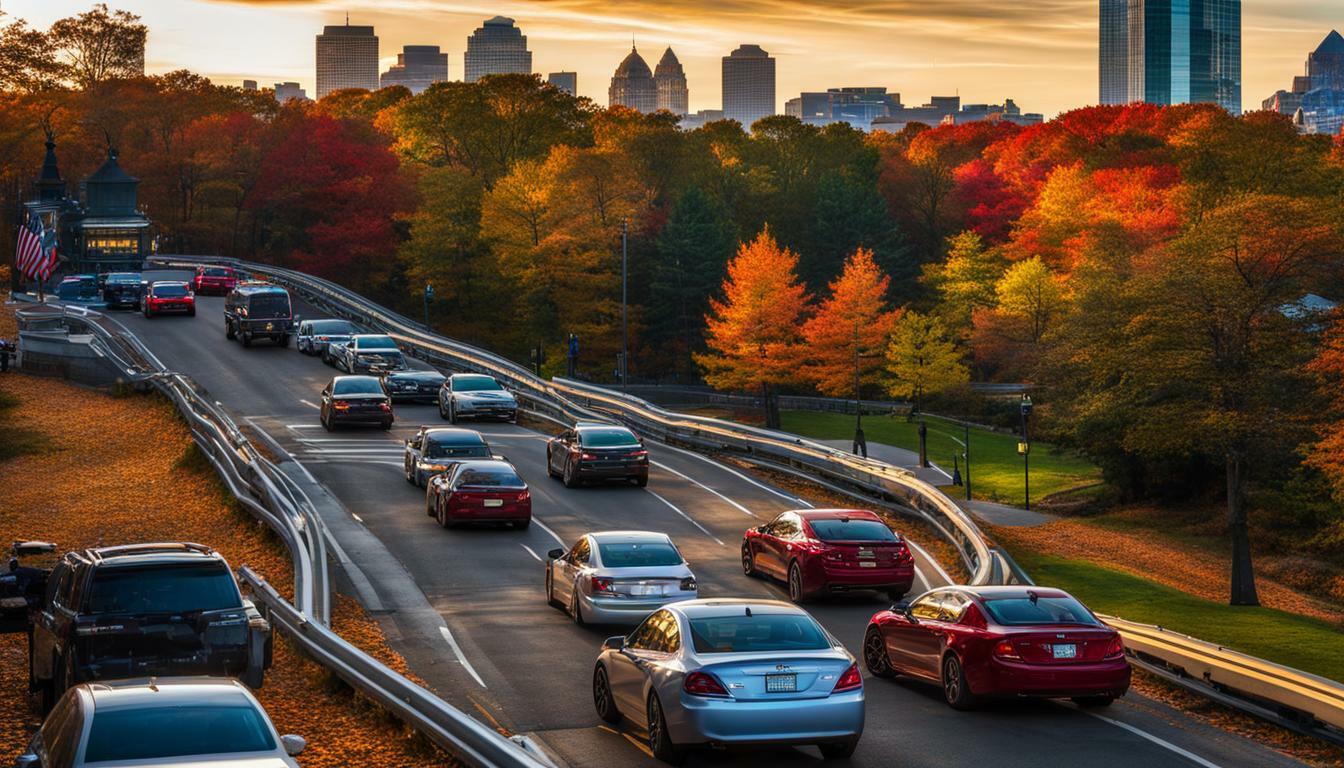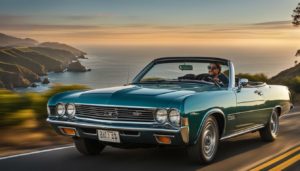Driving in Boston
Experience the thrill and challenge of driving in Boston. Navigating the city's unique roadways can be daunting, with narrow and winding streets, congestion, and aggressive pedestrians. However, with some careful planning and awareness, driving in Boston can still be an enjoyable experience.
Key Takeaways:
- Consider using public transportation or walking instead of driving in Boston.
- If driving is necessary, rent a small car for better maneuverability.
- Plan parking outside the city and utilize the subway for convenient travel.
- Be cautious with GPS directions, as they may not always be accurate.
- Expect cars to cross lanes when turning and be aware of “easing out”.
- Avoid driving during rush hours, weekends, and sporting events to minimize congestion.
- Explore parking options such as garages, reservation services, valet, or meter parking.
- Consider alternative transportation options like public transportation, biking, or ride-sharing services.
- Always yield to pedestrians and stay alert for cyclists on the road.
Navigating Boston’s Roadways
Discover the intricacies of navigating Boston's roadways. As a city known for its historic charm and numerous attractions, Boston offers a unique driving experience. However, it's important to be prepared for the challenges that come with navigating its narrow and winding streets.
First and foremost, when driving in Boston, it is recommended to rent the smallest car possible. The compact size will make maneuvering through tight spaces and finding parking much easier. Additionally, consider renting a car for the shortest time needed, as parking can be expensive and limited in the city.
While GPS can be a useful tool, it may not always provide the most accurate directions in Boston. The city's one-way streets and unique road conditions can sometimes confuse navigation systems. Therefore, it is essential to have a good understanding of the city's layout and familiarize yourself with the best driving routes beforehand.
Navigating Boston’s Roadways: Helpful Tips
- Be cautious of aggressive pedestrians who may cross the street unexpectedly. Yield to pedestrians at crosswalks and always be on the lookout for people walking or biking.
- Keep in mind that Boston drivers have a reputation for disregarding traffic signals and using turn signals sparingly. Always be prepared for cars to cross lanes of traffic when making turns.
- Exercise extra caution when “easing out” into an intersection. It's not uncommon for drivers to inch forward, even when it's not their turn to go. Always double-check before proceeding.
By following these tips and being aware of the unique challenges associated with driving in Boston, you can make your journey through the city more enjoyable and less stressful.
| Parking Options | Availability | Cost |
|---|---|---|
| Parking Garages | Ample | Varies (usually hourly rates) |
| Reservation Services | Depends on availability | Varies (usually hourly rates) |
| Valet Parking | Depends on availability | Varies (usually higher rates) |
| Meter Parking | Limited | Varies (usually city-regulated rates) |
When it comes to parking in Boston, there are various options available. Parking garages offer ample space, but prices can vary. Reservation services, such as mobile apps, can help secure a spot in advance, but availability is dependent on demand. Valet parking is another option, but it may come with higher rates. Metered street parking can be challenging to find, especially during winter and snow emergencies. It's important to plan ahead and consider these factors when deciding where to park.
Alternatively, Boston has an extensive public transportation system that can provide a convenient and stress-free way to explore the city. Biking is also a popular option, with designated bike lanes and a bike-sharing program available. Additionally, ride-sharing services like Uber and Lyft are widely used in Boston, offering a reliable alternative to driving.
Remember to always yield to pedestrians, be aware of cyclists on the road, and exercise caution when navigating Boston's roadways. By doing so, you can make the most of your time in the city while ensuring a safe and enjoyable driving experience.
Traffic and Congestion in Boston
Learn how to navigate Boston's traffic and avoid congestion. Driving in Boston can be a challenging experience, with narrow, winding streets and heavy traffic. To make your journey smoother, here are some tips for avoiding congestion and reaching your destination efficiently.
Plan your travel time
- Avoid peak hours: The traffic in Boston tends to be busiest during rush hours, which are typically from 7:00 AM to 10:00 AM in the morning and 4:00 PM to 7:00 PM in the evening. If possible, plan your travels outside these times to avoid the heaviest congestion.
- Check for events: Boston is a city known for its cultural events and sports activities. Be aware of any major events taking place, such as concerts, parades, or sports games, as they can significantly impact traffic flow. Plan your route accordingly to avoid traffic hotspots near event venues.
Alternate routes and navigation
Boston's roadways can be confusing and difficult to navigate, especially for visitors. However, with the help of modern navigation tools, you can find the best driving routes and avoid congested areas. Keep in mind the following tips:
- Utilize GPS: Use a reliable GPS system or navigation app to guide you through the city. However, be aware that GPS may not always be accurate, particularly with one-way streets and unusual road conditions. Use your judgment and refer to local maps when necessary.
- Explore alternate routes: Boston has several routes to reach the same destination. Experiment with different routes to find the ones that offer less traffic and congestion. Winding through neighborhoods or taking the scenic route may be preferable if it helps you avoid heavy traffic areas.
| Parking Options | Description |
|---|---|
| Parking Garages | Boston has numerous parking garages located throughout the city. These garages provide convenient parking options, although rates can be quite expensive. |
| Reservation Services | Consider using online reservation services to book a parking spot in advance. This can save you time and ensure you have a guaranteed parking space in busy areas. |
| Valet Parking | Some restaurants and hotels offer valet parking services, which can be a convenient option if you plan to dine out or stay overnight. However, be prepared for additional fees. |
| Meter Parking | Street parking in Boston is available through metered parking spots. Ensure you have sufficient change or use phone apps that allow you to pay for parking digitally. |
Remember, driving in Boston requires caution and patience. Be prepared for drivers who may disregard traffic signals and pedestrians who may be assertive. Always yield to pedestrians and cyclists, and follow all traffic laws to ensure the safety of yourself and others. If possible, consider using public transportation, biking, or ride-sharing services like Uber and Lyft to navigate the city more easily and avoid the challenges of driving in Boston.
Parking in Boston
Discover the ins and outs of parking in Boston. As one of the oldest cities in the United States, Boston's streets can be narrow and winding, making parking a challenge. Additionally, the city's popularity and limited space contribute to expensive rates and limited availability.
When it comes to finding parking in Boston, there are several options to consider. Parking garages are available throughout the city and offer a convenient solution, although rates can be steep. It's worth checking online reservation services beforehand to secure a spot and potentially save money. Valet parking is another option, particularly if you are visiting a hotel or restaurant in the city center.
Street parking, on the other hand, can be a bit trickier, especially during winter and snow emergencies. It's important to pay attention to parking signs and regulations to avoid tickets or towing. If you do find a spot on the street, make sure to have change for the parking meters, as they often require payment in cash or through a mobile app.
Table: Parking Options in Boston
| Parking Option | Pros | Cons |
|---|---|---|
| Parking Garages | Convenient, available throughout the city | Expensive rates |
| Reservation Services | Potential savings, guarantees a spot | Limited availability |
| Valet Parking | Convenient for hotel or restaurant visits | Can be costly |
| Street Parking | Possible to find free spots | Challenging during snow emergencies, meter payment required |
For those looking to save money and avoid the hassle of parking, Boston offers an excellent public transportation system. The subway, known as the “T,” covers the city and surrounding areas, providing an efficient and cost-effective way to get around. Alternatively, you can opt for biking or utilize ride-sharing services like Uber and Lyft, which are popular and readily available in Boston.
Regardless of your choice, it's important to be mindful of pedestrians and cyclists while driving in Boston. Yield to pedestrians in crosswalks and be cautious of cyclists sharing the road. Remember that turn signals are not always used by locals, traffic signals may be disregarded, and drivers may unexpectedly change lanes. Stay alert and drive defensively to ensure a safe and enjoyable experience on Boston's roads.
Driving Tips in Boston
Master the art of driving in Boston with these helpful tips. Navigating the city's narrow and winding streets can be challenging, but with a few pointers, you can make your journey smoother and safer.
Renting a Small Car
When renting a car in Boston, opt for the smallest size possible. With its narrow streets and tight parking spots, maneuvering a compact car will be much easier than a larger vehicle. Additionally, renting a car for the shortest time needed can help save on parking fees and avoid unnecessary stress.
Parking Outside the City
Parking in Boston can be expensive and hard to come by. Consider parking outside the city and taking public transportation, such as the subway, into downtown areas. This not only saves you money but also eliminates the hassle of searching for a parking spot. Be cautious, however, as GPS may not always be accurate due to one-way streets and complex road conditions.
Be Alert and Cautious
When driving in Boston, it's important to stay alert and cautious at all times. Traffic signals are often disregarded, and turn signals may not always be used. Expect cars to suddenly cross lanes of traffic when making turns, and be cautious of vehicles “easing out” into your lane. Keep in mind that Boston roads frequently experience congestion, especially during rush hours, summer weekends, and sporting events.
Alternative Transportation Options
If driving in Boston seems too daunting, consider utilizing the city's public transportation system or alternative transportation options. The subway, biking, and ride-sharing services like Uber and Lyft are widely available and provide convenient and reliable ways to get around. Remember to yield to pedestrians and be mindful of cyclists when sharing the road.
| Tips | Summary |
|---|---|
| Rent a small car | Maneuvering through narrow streets is easier with a compact car |
| Park outside the city | Avoid expensive parking fees and limited availability by parking outside and using public transportation |
| Be alert and cautious | Expect erratic driving behaviors and be cautious of vehicles crossing lanes and “easing out” |
| Consider alternative transportation | Utilize public transportation, biking, or ride-sharing services as an alternative to driving |
Remember, driving in Boston may be challenging, but by following these tips and staying aware of your surroundings, you can navigate the city's streets with confidence.
Public Transportation and Alternative Options
Explore the alternative transportation options available in Boston. With its bustling streets and limited parking options, relying on public transportation, biking, or ride-sharing services like Uber and Lyft can be a convenient and stress-free way to navigate the city.
Public Transportation
Boston offers a comprehensive public transportation system, known as the “T.” The Massachusetts Bay Transportation Authority (MBTA) operates subway, bus, and commuter rail services, providing easy access to various parts of the city and surrounding areas. The subway, also referred to as the “T,” has multiple lines that connect key attractions and neighborhoods. Bus routes cover a wider range of destinations and can be an efficient way to explore areas not served by the subway. The commuter rail offers transportation to suburbs and nearby towns.
Using the T is a cost-effective option, especially with the availability of various passes, such as the CharlieCard or CharlieTicket, which offer discounted fares for frequent travelers. The MBTA website provides timetables, route maps, and trip planning tools, making it easy to navigate the public transportation system in Boston.
Biking in Boston
Boston is a bike-friendly city, with numerous bike lanes and paths that allow cyclists to navigate the city safely. Renting a bike is a great way to explore Boston at your own pace, enjoying the scenic routes and stopping by popular landmarks. Many bike rental shops offer hourly or daily rates, making it convenient for both visitors and locals to experience the city on two wheels.
Boston also has a bike-sharing program called Bluebikes, formerly known as Hubway. This program allows users to rent bikes from docking stations located throughout the city and return them at any other station. Bluebikes offers a convenient and affordable way to travel short distances, providing flexibility and freedom to explore Boston by bike.
Ride-Sharing Services
When public transportation or biking is not feasible, ride-sharing services like Uber and Lyft provide a reliable and convenient option for getting around Boston. Using a ride-sharing app on your smartphone, you can request a car to pick you up and drop you off at your desired location. These services offer the convenience of door-to-door transportation, eliminating the hassle of finding parking or navigating unfamiliar streets.
Whether you choose to utilize public transportation, bike through the city streets, or rely on ride-sharing services, exploring alternative transportation options can enhance your experience in Boston. These options provide convenience, affordability, and an opportunity to immerse yourself in the vibrant atmosphere of this historic city.
| Transportation Option | Benefits |
|---|---|
| Public Transportation (The T) |
|
| Biking |
|
| Ride-Sharing Services (Uber, Lyft) |
|
Conclusion
In conclusion, driving in Boston requires careful navigation and consideration of alternative transportation methods. The city's narrow and winding streets, coupled with congestion and aggressive pedestrians, can make driving a challenging experience. Therefore, if possible, I recommend utilizing Boston's efficient public transportation system or opting to explore the city on foot.
If driving is necessary, it is advisable to rent the smallest car available and for the shortest duration needed. Parking in Boston can be both expensive and difficult to find, so parking outside the city and utilizing the subway system can be a more convenient option. It is important to note that GPS may not always be reliable due to one-way streets and unusual road conditions. Therefore, it is advisable to remain vigilant and consult a map if needed.
Furthermore, it is important to be aware that traffic signals in Boston are often disregarded, and turn signals are not consistently used. Expect cars to cross lanes when turning and exercise caution when “easing out” into traffic. Boston's roads frequently become congested, particularly during rush hours, summer weekends, and sporting events. Planning your trips accordingly can help alleviate some of the frustration caused by traffic congestion.
When it comes to parking, there are various options available, including parking garages, reservation services, valet, and meter parking. However, street parking can be particularly challenging, especially during winter and snow emergencies. Alternatively, public transportation, biking, and ride-sharing services like Uber and Lyft offer convenient and stress-free alternatives to driving in the city. Remember to yield to pedestrians and be mindful of cyclists to ensure a safe and enjoyable experience for all road users.
FAQ
Is driving in Boston difficult?
Yes, driving in Boston can be challenging due to narrow, winding streets, congestion, aggressive pedestrians, and disregard for traffic signals.
Should I avoid driving in Boston?
It is recommended to avoid driving in Boston if possible and instead use public transportation or walk.
What type of car should I rent in Boston?
It is advised to rent a small car or the smallest rental car possible to navigate the narrow streets of Boston.
Should I rent a car for a long time in Boston?
No, it is recommended to rent a car for the shortest time needed to avoid parking and other costs.
Is it difficult to find parking in Boston?
Yes, parking in Boston can be expensive and difficult to find, especially street parking.
How accurate is GPS in Boston?
GPS may not always be accurate in Boston, particularly with one-way streets and unusual road conditions.
Do drivers follow traffic signals in Boston?
Traffic signals are often disregarded in Boston, and turn signals are not always used.
When does traffic in Boston get congested?
Boston roads frequently get congested, especially during rush hours, summer weekends, and sporting events.
What are the options for parking in Boston?
There are parking garages, reservation services, valet, and meter parking options in Boston, but street parking can be challenging, particularly during winter and snow emergencies.
What are the alternative transportation options in Boston?
Public transportation, biking, and ride-sharing services like Uber and Lyft are available in Boston.
Do drivers need to yield to pedestrians in Boston?
Yes, drivers should yield to pedestrians and be aware of cyclists in Boston.



